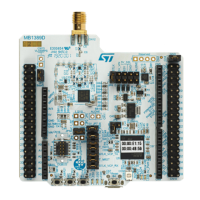RM0453 Rev 1 1043/1461
RM0453 Tamper and backup registers (TAMP)
1057
33.3.2 TAMP pins and internal signals
The TAMP kernel clock is usually the LSE at 32.768 kHz although it is possible to select
other clock sources in the RCC (refer to RCC for more details). Some detections modes are
not available in some low-power modes or V
BAT
when the selected clock is not LSE (refer to
Section 33.4: TAMP low-power modes for more details.
Table 216. TAMP input/output pins
Pin name Signal type Description
TAMP_INx (x = pin index) Input Tamper input pin
Table 217. TAMP internal input/output signals
Internal signal name Signal type Description
tamp_ker_ck Input
TAMP kernel clock, connected to rtc_ker_ck
and also named RTCCLK in this document
tamp_pclk Input TAMP APB clock, connected to rtc_pclk
tamp_itamp[y]
(y = signal index)
Inputs Internal tamper event sources
tamp_evt Output
Tamper event detection (internal or external)
The tamp_evt is used to generate a RTC
timestamp event
tamp_erase Output
Device secrets erase request following either
tamper event detection (internal or external) or
the software erase request done by writing
BKERASE to 1
tamp_it Output
TAMP interrupt (refer to Section 33.5: TAMP
interrupts for details)
tamp_trg[x]
(x = signal index)
Output Tamper detection trigger
Table 218. TAMP interconnection
Signal name Source/Destination
tamp_evt rtc_tamp_evt used to generate a timestamp event
tamp_erase
The tamp_erase signal is used to erase the device secrets listed
hereafter: backup registers, SRAM2 and PKA SRAM
tamp_itamp3 LSE monitoring
tamp_itamp5 RTC calendar overflow (rtc_calovf)
tamp_itamp6 JTAG access in RDP level 1
tamp_itamp8
(1)
1. This signal is generated in the TAMP peripheral.
Monotonic counter overflow

